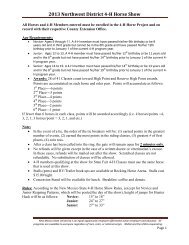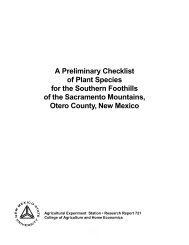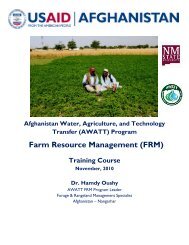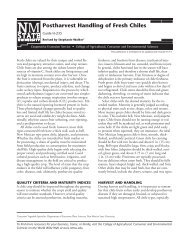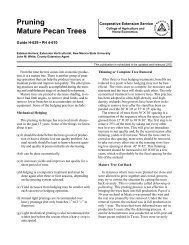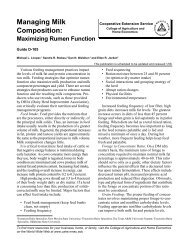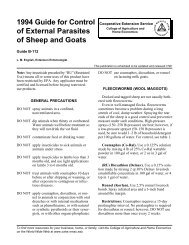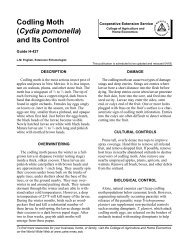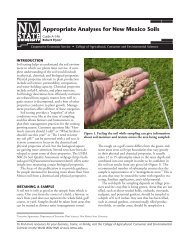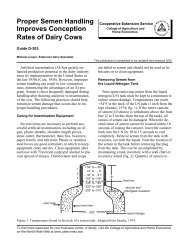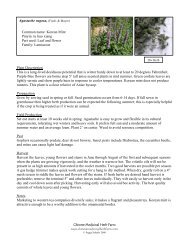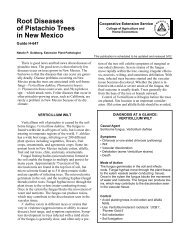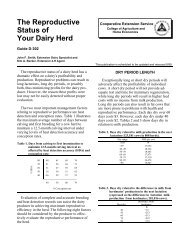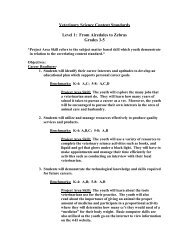Burning for Big Game - College of Agricultural, Consumer and ...
Burning for Big Game - College of Agricultural, Consumer and ...
Burning for Big Game - College of Agricultural, Consumer and ...
Create successful ePaper yourself
Turn your PDF publications into a flip-book with our unique Google optimized e-Paper software.
<strong>Burning</strong> <strong>for</strong> <strong>Big</strong> <strong>Game</strong><br />
Circular 657<br />
Louis C. Bender 1<br />
Cooperative Extension Service • <strong>College</strong> <strong>of</strong> <strong>Agricultural</strong>, <strong>Consumer</strong> <strong>and</strong> Environmental Sciences<br />
Prescribed burning is a management tool that is increasingly<br />
used to alter the composition <strong>and</strong> structure <strong>of</strong><br />
vegetation on public <strong>and</strong> private l<strong>and</strong>s in New Mexico.<br />
<strong>Burning</strong> is frequently prescribed to increase habitat<br />
quality <strong>for</strong> big game species, such as mule deer (Odocoileus<br />
hemionus), elk (Cervus elaphus), <strong>and</strong> pronghorn<br />
(Antilocapra americana), <strong>and</strong> can be an economically<br />
viable alternative to more costly management practices,<br />
such as <strong>for</strong>age plots or feeding, <strong>for</strong> increasing the quality<br />
<strong>of</strong> wildlife habitat <strong>and</strong> economics <strong>of</strong> wildlife enterprises.<br />
However, there are significant differences between burning<br />
to benefit big game <strong>and</strong> their habitat <strong>and</strong> burning<br />
<strong>for</strong> other ecological factors, such as brush control, mimicking<br />
“natural” fire regimes, or urban-interface clearing.<br />
Optimal burning prescriptions <strong>for</strong> big game habitat differ<br />
from other burning prescriptions in terms <strong>of</strong> season<br />
<strong>of</strong> burn, intensity <strong>of</strong> burn, <strong>and</strong> other factors. This results<br />
in many burns, even if conducted to benefit big game,<br />
actually having fewer positive benefits than they could<br />
have. Hence, it is important to underst<strong>and</strong> how to burn<br />
to maximize benefits <strong>for</strong> big game.<br />
Prescribed burns <strong>for</strong> big game are most common in<br />
conifer <strong>for</strong>ests <strong>and</strong> woodl<strong>and</strong>s, but are also valuable in<br />
grassl<strong>and</strong>s <strong>and</strong> shrubl<strong>and</strong>s. The effects <strong>of</strong> fire vary with<br />
the intensity <strong>and</strong> timing <strong>of</strong> the burn (Whelan, 1995;<br />
Arno <strong>and</strong> Allison-Bunnell, 2002). For managing big<br />
game habitat, most prescribed fire is low-intensity because<br />
<strong>of</strong> the danger <strong>of</strong> losing control <strong>of</strong> a high-intensity<br />
crown fire (Whelan, 1995; Lutz et al., 2003; Fulé et<br />
al., 2004) <strong>and</strong> because cooler fires are promoted during<br />
optimal burning periods. Fire can have several major<br />
effects on wildlife habitat; the following sections generalize<br />
the effects <strong>of</strong> fire on big game habitat.<br />
Community structure. Fire has its greatest impact<br />
on the structure <strong>of</strong> plant communities, usually by<br />
retarding succession. It does this (1) by shifting communities<br />
from tree-dominated overstory to grass/<strong>for</strong>b or<br />
shrub communities (Whelan, 1995) <strong>and</strong> (2) by eliminating<br />
dead aboveground biomass (Hobbs <strong>and</strong> Spowart,<br />
1984). For example, fire can increase the quality <strong>of</strong> big<br />
game diets to a much greater extent than gains derived<br />
from increased nutrients in <strong>for</strong>ages because it removes<br />
dead plant material <strong>and</strong> thus allows animals access to<br />
newly emergent <strong>for</strong>ages in early phenological states<br />
(i.e., high in cell-soluble nutrients) (Hobbs <strong>and</strong><br />
Spowart, 1984).<br />
Plant biomass. Biomass increases after burning due<br />
to a combination <strong>of</strong> fertilization <strong>and</strong> partial to full opening<br />
<strong>of</strong> the tree or shrub overstory (Jones <strong>and</strong> DeByle,<br />
1985; Whelan, 1995).<br />
Green-up. Fire tends to speed spring green-up <strong>of</strong><br />
vegetation, at least in the first year. This occurs because<br />
the blackened ash left after burning warms in the sun,<br />
creating a warmer microclimate <strong>for</strong> plants to germinate<br />
or initiate growth (Hobbs <strong>and</strong> Spowart, 1984).<br />
Plant composition. Fire can change the composition<br />
<strong>of</strong> plant communities depending upon the intensity <strong>and</strong><br />
frequency <strong>of</strong> burning (Whelan, 1995). Intense fires can<br />
eliminate entire overstory tree communities, while frequent<br />
low-intensity fires can change plant composition<br />
by eliminating less fire-tolerant species (shrubs, which<br />
store reserves above ground) in favor <strong>of</strong> more fire-tolerant<br />
species (perennial grasses, which store reserves below<br />
ground) (Jones <strong>and</strong> DeByle, 1985; Whelan, 1995). In<br />
grassl<strong>and</strong>s, frequent fire can also cause species shifts<br />
away from perennial grasses to <strong>for</strong>bs (Ford <strong>and</strong> McPherson,<br />
1996). Forbs can also be preferentially increased<br />
in abundance by spring fires as compared to burning in<br />
other seasons (Brewer <strong>and</strong> Platt, 1994).<br />
Fertilization <strong>and</strong> nutrients. Increases in understory<br />
biomass, improvement <strong>of</strong> diet quality beyond levels<br />
attributable to increased <strong>for</strong>age quality alone (Hobbs<br />
<strong>and</strong> Spowart, 1984), <strong>and</strong> effects on nutritional quality<br />
<strong>of</strong> plants are the three principal benefits <strong>of</strong> fire <strong>for</strong><br />
big game. The primary effect <strong>of</strong> fire on nutrients is in<br />
protein levels, <strong>and</strong> is caused by freeing the nitrogen (N)<br />
bound in litter, especially the high carbon:nitrogen ratio<br />
(C:N) litter <strong>of</strong> conifer-dominated communities. In<br />
1 Research Scientist (Wildlife), Department <strong>of</strong> Extension Animal Sciences <strong>and</strong> Natural Resources, New Mexico State University.<br />
To find more resources <strong>for</strong> your business, home, or family, visit the <strong>College</strong> <strong>of</strong> <strong>Agricultural</strong>, <strong>Consumer</strong> <strong>and</strong> Environmental<br />
Sciences on the World Wide Web at aces.nmsu.edu
general, fire increases protein levels approximately 25%,<br />
although this can range as high as 145% (L. Bender,<br />
unpublished data). Further, the effects <strong>of</strong> fire on protein<br />
can vary with several factors, including:<br />
1. Plant species. In general, grasses show the least<br />
response to fire, <strong>and</strong> shrubs the greatest. This is because<br />
grasses tend to store nutrients below ground,<br />
so burning the cured above-ground biomass frees few<br />
nutrients. Conversely, shrubs maintain much <strong>of</strong> their<br />
live tissue above ground, so burning potentially frees<br />
many more nutrients.<br />
2. N content <strong>of</strong> soils. If soils are high in N, gains from<br />
burning will be less. For vegetation types present in<br />
New Mexico, the greatest nutrient gains would occur<br />
in conifer-dominated systems (piñon-juniper <strong>and</strong><br />
montane conifer) because <strong>of</strong> the high C:N ratio <strong>of</strong><br />
their litter <strong>and</strong> consequent slow decomposition rates.<br />
3. Time since burn. Protein (<strong>and</strong> other nutrient) gains<br />
from burning are relatively short-term, generally<br />
lasting only 1 to 2 years. After 3 to 5 years, there is<br />
usually no detectable difference. However, the total<br />
<strong>for</strong>age biomass response to burning lasts significantly<br />
longer, <strong>and</strong> only begins to change as the overstory<br />
canopy closes.<br />
4. Season <strong>of</strong> burn. Prescribed burns (or any other management<br />
actions) should provide needed nutrients<br />
when required by the target species. The season <strong>of</strong><br />
burn is important because different seasons result in<br />
different times <strong>of</strong> increased protein levels in <strong>for</strong>age. In<br />
general, the relationships between season <strong>of</strong> burn <strong>and</strong><br />
protein levels in plants are as follows (Einarsen, 1946;<br />
DeWitt <strong>and</strong> Derby, 1955; Grelen <strong>and</strong> Epps, 1967;<br />
Dills, 1970; Hobbs <strong>and</strong> Spowart, 1984).<br />
a. Winter burns. Result in protein increases in<br />
early spring; protein levels decline throughout<br />
the summer.<br />
b. Spring burns. Result in protein increase in late<br />
spring <strong>and</strong> early summer; protein levels decline<br />
throughout mid- <strong>and</strong> late summer.<br />
c. Summer burns. Result in a large increase in protein<br />
in mid-summer followed by a rapid decline in<br />
late summer.<br />
d. Autumn burns. Generally result in little response<br />
because plants have little time to make a growth<br />
response; also poses the greatest threat <strong>of</strong> loss <strong>of</strong><br />
nutrients due to run<strong>of</strong>f, leaching, <strong>and</strong> windblow<br />
because <strong>of</strong> the length <strong>of</strong> exposure be<strong>for</strong>e plants<br />
initiate growth in early spring.<br />
Circular 657 • Page 2<br />
Fire can also affect other nutrients. Fire tends to<br />
decrease crude fiber <strong>of</strong> plants, thus increasing digestibility.<br />
Because digestibility <strong>and</strong> digestible energy are<br />
synonymous, fire there<strong>for</strong>e results in increased energy<br />
available, both within plants (because <strong>of</strong> increased digestibility)<br />
<strong>and</strong> overall (because <strong>of</strong> increased plant biomass)<br />
(Edwards et al., 2004). Gains in digestibility tend<br />
to be longer lived than protein gains, lasting as long as<br />
10 years or until significant competition begins to cause<br />
declines in understory biomass. Fire has variable effects<br />
on mineral levels <strong>of</strong> <strong>for</strong>ages, with spring burns tending<br />
to increase mineral levels <strong>and</strong> burns in other seasons<br />
having little effect. Fire has a small effect on fat levels<br />
(ether extracts) <strong>of</strong> plants; grasses in general tend to show<br />
increased ether extracts after burning.<br />
For big game, the key periods <strong>of</strong> energy, mineral,<br />
<strong>and</strong> especially protein needs are late spring <strong>and</strong> summer,<br />
corresponding with the last trimester <strong>of</strong> gestation,<br />
lactation, <strong>and</strong> antler growth (Verme <strong>and</strong> Ullrey, 1984;<br />
Wakeling <strong>and</strong> Bender, 2003). During this period, dem<strong>and</strong>s<br />
<strong>for</strong> both protein <strong>and</strong> energy are greatest to invest<br />
in the growing fetus <strong>and</strong> to maintain lean muscle tissue<br />
or accumulate fat in the female. High protein content<br />
in milk is critical <strong>for</strong> rapid growth <strong>of</strong> juveniles (L<strong>and</strong>ete-<br />
Castilljos et al., 2003) <strong>and</strong> maintenance <strong>of</strong> female body<br />
mass, both <strong>of</strong> which are critical <strong>for</strong> the survival <strong>of</strong> fawns<br />
<strong>and</strong> adults (Bender et al., 2007; Lomas <strong>and</strong> Bender,<br />
2007; Hoenes, 2008). Similarly, growing antlers are<br />
more than 80% protein, so bucks <strong>and</strong> bulls require a<br />
minimum <strong>of</strong> 16%, <strong>and</strong> ideally more than 20%, protein<br />
in their diets during the primary antler growth period<br />
from late April through early September (Bender, 2011).<br />
Late winter <strong>and</strong> spring burns (generally March to April,<br />
depending on the location in New Mexico) can provide<br />
a critical protein flush during this period, thereby increasing<br />
survival, productivity, <strong>and</strong> per<strong>for</strong>mance <strong>of</strong> big<br />
game. Additionally, spring burns can also increase mineral<br />
content <strong>of</strong> <strong>for</strong>ages, providing minerals during the<br />
period <strong>of</strong> rapid antler development in males (Bender,<br />
2011). <strong>Big</strong> game will also consume ash following a<br />
burn, which provides a further, direct source <strong>of</strong> minerals<br />
in their diets.<br />
Later burns, as are typical <strong>of</strong> public l<strong>and</strong>s in New<br />
Mexico (i.e., June to August), can still increase biomass<br />
<strong>of</strong> <strong>for</strong>age <strong>for</strong> big game, but much <strong>of</strong> the beneficial effects<br />
<strong>of</strong> burning on nutrient content <strong>and</strong> rapid green-up <strong>of</strong><br />
<strong>for</strong>age are lost. Because the freeing <strong>of</strong> nutrients is probably<br />
the most important advantage <strong>of</strong> fire over mechanical<br />
<strong>and</strong> herbicidal treatments <strong>for</strong> big game, managers<br />
should burn early to maximize nutrient benefits if big<br />
game habitat is the primary reason <strong>for</strong> prescribed burns.<br />
Additionally, late winter <strong>and</strong> spring burns are cooler<br />
than later burns, resulting in less mortality <strong>of</strong> shrubs
Figure 1. Thorough herbaceous burn in short grassl<strong>and</strong>.<br />
<strong>Burning</strong> in late winter will encourage production <strong>of</strong> <strong>for</strong>bs,<br />
which are important big game foods. Perennial grasses will<br />
remain, but their coverage will be decreased 10 to 15% to<br />
open space <strong>for</strong> <strong>for</strong>bs. This relatively cool burn maintained<br />
the juniper at the crest <strong>of</strong> the hill as cover.<br />
<strong>and</strong> remaining tree overstory, which maintains critical<br />
<strong>for</strong>ages (shrubs) <strong>and</strong> cover components (trees) while<br />
increasing quality <strong>and</strong> quantity <strong>of</strong> <strong>for</strong>ages (Figure 1).<br />
Thus, burns aimed at increasing nutritional quality <strong>of</strong><br />
big game ranges should be timed <strong>for</strong> late winter or early<br />
spring to increase availability <strong>of</strong> key nutrients <strong>for</strong> big<br />
game productivity at the critical time they are required.<br />
The exact fire behavior <strong>and</strong> burn plan are highly<br />
dependent on the local vegetation <strong>and</strong> topography, <strong>and</strong><br />
thus need to be developed on a site-specific basis. In<br />
general, low humidity <strong>and</strong> a 5 to 10 mph wind provide<br />
ideal burning characteristics with 1 to 2 ft flame lengths.<br />
Fire intensity, <strong>and</strong> thus flame lengths, need to be higher<br />
if a significant kill <strong>of</strong> overstory trees is a management<br />
objective (Figure 2). Headfires (burning in the direction<br />
the wind is blowing) will provide a fast, patchy burn<br />
that is ideal <strong>for</strong> minimizing mortality <strong>of</strong> woody shrubs<br />
<strong>and</strong> creating a mosaic <strong>of</strong> burned <strong>and</strong> unburned patches,<br />
which is <strong>of</strong>ten optimal <strong>for</strong> big game habitat (Figure 3).<br />
<strong>Burning</strong> across the wind (flankfire) or into the wind<br />
(backfire) results in progressively slower, hotter, <strong>and</strong><br />
less patchy burns. These burns will usually result in<br />
increased shrub <strong>and</strong> tree mortality. Similarly, upslope<br />
burns are usually faster <strong>and</strong> patchier than downslope<br />
burns. Managers thus need to consider plant biomass<br />
(fuel load), topography, desired vegetation changes (<strong>for</strong><br />
example, high or low shrub kill), <strong>and</strong> weather when<br />
planning their burns <strong>for</strong> big game habitat (Figure 4).<br />
Assistance in fire planning is available from the Cooperative<br />
Extension Service as well as county, state, <strong>and</strong><br />
federal l<strong>and</strong> management agencies.<br />
Circular 657 • Page 3<br />
Figure 2. Even late winter burns in March can generate<br />
long flame lengths <strong>and</strong> intense fire. Managers need to<br />
tailor fire intensity to burn objectives—the greater the<br />
intensity, the higher the kill <strong>of</strong> woody species, which is<br />
counterproductive <strong>for</strong> many big game burns.<br />
<strong>Burning</strong> Considerations in Selected<br />
Plant Communities<br />
Some general considerations <strong>for</strong> burning to promote big<br />
game habitat in the more common plant communities<br />
<strong>of</strong> New Mexico are given in the following sections.<br />
Piñon (Pinus edulis)-juniper (Juniperus spp.)<br />
woodl<strong>and</strong>. Most <strong>for</strong>age benefits <strong>for</strong> big game in piñonjuniper<br />
come from increasing <strong>for</strong>age biomass by opening<br />
the piñon-juniper overstory (Van Hooser et al.,<br />
1993), but changes in big game use following mechanical<br />
manipulation only (thinning, cabling, chaining, etc.)<br />
have been mixed (Howard et al., 1987). In contrast, big<br />
game consistently show positive responses to burning<br />
piñon-juniper (Greenwood et al., 1999; Erskine <strong>and</strong><br />
Goodrich, 1999). This is because conifer-dominated<br />
communities have litter with a high C:N ratio that results<br />
in slow rates <strong>of</strong> decomposition since microbial decomposers<br />
are limited by a lack <strong>of</strong> N to build microbial<br />
protein (i.e., bodies) (Miller et al., 1979). Consequently,<br />
most conifer systems are nutrient deficient because most<br />
nutrients, especially N, are tied up in the trees or litter.<br />
Fire, by converting litter <strong>and</strong> tree biomass to ash,<br />
frees nutrients <strong>and</strong> makes them available to understory<br />
grasses, <strong>for</strong>bs, <strong>and</strong> shrubs (Miller et al., 1979; White,<br />
1994; Whelan, 1995), increasing <strong>for</strong>age quality. Along<br />
with opening the overstory, the combination <strong>of</strong> mineral<br />
soil, high nutrient availability, <strong>and</strong> sunlight provides<br />
ideal conditions <strong>for</strong> establishment <strong>of</strong> shade-intolerant<br />
species (Whelan, 1995; Arno <strong>and</strong> Allison-Bunnell,<br />
2002; Schoennagel et al., 2004), which includes most<br />
preferred <strong>for</strong>ages <strong>of</strong> big game.
Figure 3. Late winter burns are frequently patchy, resulting<br />
in a mosaic <strong>of</strong> burned <strong>and</strong> unburned areas. This increases<br />
the diversity <strong>of</strong> the rangel<strong>and</strong> <strong>and</strong> the variety <strong>of</strong><br />
<strong>for</strong>age available to big game <strong>and</strong> livestock.<br />
Two important considerations in burning piñon-juniper<br />
are frequency <strong>of</strong> burning <strong>and</strong> intensity <strong>of</strong> burning.<br />
Longer fire intervals, on the range <strong>of</strong> 8 to 12 years, favor<br />
the establishment <strong>of</strong> shrubs in the understory. Conversely,<br />
shorter intervals <strong>of</strong> 3 to 5 years can eliminate<br />
shrubs <strong>and</strong> favor grasses <strong>and</strong> <strong>for</strong>bs. For big game species,<br />
such as deer <strong>and</strong> pronghorn that require the highest<br />
quality diets, shrubs are critical <strong>for</strong> maintaining adult<br />
survival in areas characterized by frequent drought such<br />
as most <strong>of</strong> New Mexico (Bender et al., in press). In these<br />
cases, longer fire intervals should be favored to maintain<br />
<strong>and</strong> enhance shrub communities. Similarly, smaller big<br />
game species such as mule deer depend on significant<br />
hiding cover, <strong>and</strong> all big game will use overstory thermal<br />
cover in New Mexico (Hoenes, 2008). Consequently, it<br />
is not desirable to eliminate all overstory piñon-juniper<br />
(or even a substantial portion <strong>of</strong> it in certain areas), so<br />
late winter to early spring fires that limit mortality <strong>of</strong><br />
residual trees should be used to maintain cover as well as<br />
to maximize nutrient benefits <strong>of</strong> burning.<br />
Montane conifer. Overstory canopy coverage is similarly<br />
the single most important variable in determining<br />
the biomass <strong>and</strong> composition <strong>of</strong> understory communities<br />
in montane conifer types (Pieper, 1990; Canham et<br />
al., 1994; Thomas et al., 1999). Fire can work in combination<br />
with thinning to greatly enhance the quantity<br />
<strong>and</strong> quality <strong>of</strong> understory <strong>for</strong>age in montane conifer<br />
types (Oswald <strong>and</strong> Covington, 1983; Covington et al.,<br />
1997). The effects <strong>of</strong> fire on <strong>for</strong>age are identical to those<br />
described under piñon-juniper, except that understory<br />
responses tend to be greater because montane conifer<br />
tends to have greater canopy coverage <strong>and</strong> occurs in<br />
Circular 657 • Page 4<br />
Figure 4. A good big game burn in open piñon-juniper<br />
<strong>and</strong> oakbrush. The herbaceous layer is mostly burned but<br />
some patches remain, some <strong>of</strong> the oakbrush is topkilled<br />
<strong>and</strong> will re-sprout, <strong>and</strong> much <strong>of</strong> the scattered piñon-<br />
juniper will survive.<br />
more mesic (higher moisture level) sites, providing more<br />
water <strong>for</strong> understory response. Thinning <strong>and</strong> prescribed<br />
burning have consistently resulted in significant increases<br />
in elk <strong>and</strong> deer use <strong>of</strong> montane st<strong>and</strong>s (Lowe et al.,<br />
1978; Roberts <strong>and</strong> Tiller, 1985; Crouch, 1986). Burn<br />
intervals need to be adjusted as described under piñonjuniper<br />
to favor shrubs or grasses, depending on management<br />
goals, but burning intervals in montane conifer<br />
should be at the shorter end <strong>of</strong> the ranges listed, whereas<br />
most piñon-juniper sites should be burned at the longer<br />
intervals in the ranges listed. Residual overstory trees<br />
also suffer less mortality than residual piñon-juniper<br />
during follow-up burns.<br />
Aspen (Populus tremuloides). In higher-elevation<br />
mesic sites in New Mexico, remnant aspen st<strong>and</strong>s provide<br />
extremely high-quality big game habitat. Aspen<br />
is shade-intolerant, so regeneration requires complete<br />
removal <strong>of</strong> the overstory (Bartos, 2001). In the past, this<br />
naturally occurred through st<strong>and</strong>-replacing wildfire, but<br />
more recently is a result <strong>of</strong> patch- or clear-cutting. If<br />
st<strong>and</strong>s are cut, aspen regenerates much more vigorously if<br />
burned after cutting (Shepherd, 2001) due to near complete<br />
elimination <strong>of</strong> auxins (a class <strong>of</strong> plant hormone),<br />
which inhibit suckering (vegetative regrowth). Also, if a<br />
shade-tolerant conifer understory is present in mature aspen<br />
st<strong>and</strong>s, conifers need to be killed by cutting or burning<br />
to regenerate aspen (Patton <strong>and</strong> Jones, 1977). Aspen<br />
reproduces poorly (if at all) from seed in the Southwest<br />
because <strong>of</strong> a lack <strong>of</strong> suitable soil characteristics <strong>and</strong> adequate<br />
moisture (Shepherd, 2001).<br />
Because aspen is short-lived (100 to 125 years), many<br />
<strong>of</strong> the st<strong>and</strong>s that are successionally changing to
Douglas-fir (Pseudotsuga menziesii) <strong>and</strong> spruce (Picea<br />
spp.)/fir (Abies spp.) communities due to fire exclusion<br />
after approximately 1900 are in danger <strong>of</strong> being<br />
lost permanently. Aspen has declined in New Mexico<br />
from approximately 1.142 million acres historically to<br />
approximately 140,000 acres currently (Bartos, 2001).<br />
While burning can most effectively regenerate aspen,<br />
the challenge is treating enough acreage to allow adequate<br />
regeneration without losing small treatments to<br />
ungulate browsing (Shepherd, 2001). For production <strong>of</strong><br />
browse <strong>for</strong> deer <strong>and</strong> elk, an optimal rotation age is 20 to<br />
30 years <strong>for</strong> aspen (Patton <strong>and</strong> Jones, 1977).<br />
Short grassl<strong>and</strong>s. Fire is the predominant <strong>for</strong>ce in<br />
short grass management (Ford <strong>and</strong> McPherson, 1996).<br />
In general, fire results in a short-term (1 to 3 years)<br />
decrease in overall production <strong>of</strong> short grassl<strong>and</strong>s, although<br />
this effect varies with precipitation; if precipitation<br />
is normal or above normal, the effect may be<br />
absent or last approximately 1 year, but if precipitation<br />
is below normal the effect may last <strong>for</strong> up to 3 years<br />
(Launchbaugh, 1964; Wright <strong>and</strong> Bailey, 1980; Ford<br />
<strong>and</strong> McPherson 1996). <strong>Burning</strong> increases <strong>for</strong>b density<br />
<strong>and</strong> diversity in short grassl<strong>and</strong>s (Bailey <strong>and</strong> Anderson,<br />
1978; Collins <strong>and</strong> Barber, 1985; Ford <strong>and</strong> McPherson,<br />
1996), enhancing <strong>for</strong>age quality <strong>for</strong> big game, which<br />
make limited use <strong>of</strong> grasses (excluding elk) but <strong>for</strong>age<br />
heavily on <strong>for</strong>bs when available (Pederson <strong>and</strong> Harper,<br />
1978; Wakeling <strong>and</strong> Bender, 2003). For short grassl<strong>and</strong>s,<br />
spring burns on a 3 to 5 year interval can provide<br />
an ideal balance <strong>of</strong> <strong>for</strong>bs <strong>and</strong> grasses, <strong>and</strong> along with<br />
fertilization effects can significantly enhance big game<br />
habitat quality. However, the decrease in perennial<br />
grasses may lower grazing capacity <strong>for</strong> cattle. In desert<br />
grassl<strong>and</strong>s, burn intervals are generally much longer <strong>and</strong><br />
depend on the rate <strong>of</strong> plant recovery <strong>and</strong> production<br />
following burning.<br />
Fire can reduce woody plant cover (Ford <strong>and</strong><br />
McPherson, 1996), <strong>and</strong> because short grassl<strong>and</strong>s <strong>of</strong>ten<br />
lack cover <strong>for</strong> species such as mule deer, short grass<br />
prairie sites with woody cover (or where woody cover is<br />
being established) should be burned with very low intensity<br />
spring fires at longer intervals <strong>of</strong> 8 to 10 years.<br />
Shrubl<strong>and</strong>s. Oakbrush (Quercus spp.) <strong>and</strong> true<br />
mountain mahogany (Cercocarpus montanus) are the<br />
shrubl<strong>and</strong> vegetation most benefitted by burning in<br />
New Mexico, although bitterbrush (Purshia tridentata)<br />
<strong>and</strong> sagebrush (Artemisia spp.; most commonly<br />
Circular 657 • Page 5<br />
A. tridentata <strong>and</strong> A. filifolia) can also benefit from burning.<br />
Because shrubs store reserves above ground, fire<br />
frequencies need to be longer to avoid stressing or eliminating<br />
shrubs, <strong>and</strong> burns should be in dormant seasons<br />
to minimize mortality as well as provide the optimal<br />
nutritional benefits <strong>for</strong> big game. In general, burn intervals<br />
<strong>of</strong> 8 to 10 years are ideal <strong>for</strong> rejuvenating shrubl<strong>and</strong>s,<br />
as well as minimizing the density <strong>of</strong> regeneration<br />
<strong>of</strong> sprouting species after fire. With many browse species,<br />
re-sprouting after burning can be extremely dense;<br />
however, seeding with herbaceous species after burning<br />
or using mechanical disturbance between fires can<br />
decrease the density <strong>of</strong> sprouts, resulting in more open<br />
st<strong>and</strong>s with a more diverse <strong>and</strong> productive herbaceous<br />
understory (Stevens <strong>and</strong> Davis, 1985). Such a treatment<br />
can greatly enhance the overall quality <strong>of</strong> these<br />
areas <strong>for</strong> big game.<br />
Oakbrush is the most widely distributed shrub community<br />
in New Mexico, <strong>and</strong> oakbrush is an extremely<br />
aggressive re-sprouter from root crowns following burning<br />
or other disturbance (Harrington, 1985). Oakbrush<br />
should be burned in winter or early spring, which does<br />
not harm the clones <strong>and</strong> encourages re-sprouting; hot<br />
summer burns can inhibit regrowth <strong>and</strong> may kill clones<br />
(Harrington, 1985). When rejuvenated by burning, big<br />
game use <strong>of</strong> oakbrush greatly increases (Stevens <strong>and</strong> Davis,<br />
1985); in contrast to mountain mahogany, oakbrush<br />
browse is only moderately palatable, <strong>and</strong> young shoots<br />
<strong>and</strong> new growth are the most preferred portions <strong>of</strong> the<br />
shrubs, likely because rapidly growing new growth contains<br />
fewer tannins (James et al., 1980).<br />
For species such as sagebrush <strong>and</strong> bitterbrush that<br />
are more vulnerable to fire-induced mortality, burning<br />
should be limited to dormant season fires, particularly<br />
in late winter (Stevens <strong>and</strong> Monsen, 2004), <strong>and</strong> fire<br />
intervals may need to be extended to 20 years or more,<br />
depending on the level <strong>of</strong> fire-induced mortality. Sagebrush<br />
in particular is easily killed by fire, so burned areas<br />
should be relatively small, resulting in a mix <strong>of</strong> sage <strong>and</strong><br />
herbaceous plants. Fire intervals should be timed to the<br />
closing <strong>of</strong> the sagebrush canopy; ideal cover is less than<br />
50% sagebrush. In areas such as northwestern New<br />
Mexico where cheatgrass (Bromus tectorum) is present,<br />
additional actions, such as seeding with desirable grasses<br />
<strong>and</strong> <strong>for</strong>bs, may be necessary to prevent the burned areas<br />
from becoming dominated by this noxious invasive<br />
exotic grass.
Literature Cited<br />
Arno, S.F., <strong>and</strong> S. Allison-Bunnell. 2002. Flames in our<br />
<strong>for</strong>est: Disaster or renewal? Washington, D.C.:<br />
Isl<strong>and</strong> Press.<br />
Bailey, A.W., <strong>and</strong> M.L. Anderson. 1978. Prescribed<br />
burning <strong>of</strong> a Festuca-Stipa grassl<strong>and</strong>. Journal <strong>of</strong> Range<br />
Management, 31, 446–449.<br />
Bartos, D.L. 2001. L<strong>and</strong>scape dynamics <strong>of</strong> aspen <strong>and</strong><br />
conifer <strong>for</strong>ests. In W.D. Shepherd, D. Binkley, D.L.<br />
Bartos, T.J. Stohlgren, <strong>and</strong> L.G. Eskew (Compilers),<br />
Sustaining aspen in western l<strong>and</strong>scapes: Symposium<br />
proceedings (pp. 5–14) [United States Forest Service<br />
Proceedings RMRS-P-18]. Fort Collins, CO: U.S.<br />
Department <strong>of</strong> Agriculture, Forest Service, Rocky<br />
Mountain Research Station.<br />
Bender, L.C. 2011. Basics <strong>of</strong> trophy management [Guide<br />
L-111]. Las Cruces: New Mexico State University<br />
Cooperative Extension Service.<br />
Bender, L.C., L.A. Lomas, <strong>and</strong> J. Browning. 2007. Condition,<br />
survival, <strong>and</strong> cause-specific mortality <strong>of</strong> adult<br />
female mule deer in north-central New Mexico. Journal<br />
<strong>of</strong> Wildlife Management, 71, 1,118–1,124.<br />
Bender, L.C., J.C. Boren, H. Halbritter, <strong>and</strong> S. Cox. In<br />
press. Condition, survival, <strong>and</strong> productivity <strong>of</strong> mule<br />
deer in semiarid grassl<strong>and</strong>-woodl<strong>and</strong> in east-central<br />
New Mexico. Human-Wildlife Interactions.<br />
Brewer, J.S., <strong>and</strong> W.J. Platt. 1994. Effects <strong>of</strong> fire season<br />
<strong>and</strong> herbivory on the reproductive success <strong>of</strong> a clonal<br />
<strong>for</strong>b, Pityopsis graminifolia (Michx) Nutt. Journal <strong>of</strong><br />
Ecology, 82, 665–675.<br />
Canham, C.D., A.C. Finzi, S.W. Pacala, <strong>and</strong> D.H. Burbank.<br />
1994. Causes <strong>and</strong> consequences <strong>of</strong> resource<br />
heterogeneity in <strong>for</strong>ests: Interspecific variation in<br />
light transmission by canopy trees. Canadian Journal<br />
<strong>of</strong> Forest Research, 24, 337–349.<br />
Collins, S.L., <strong>and</strong> S.C. Barber. 1985. Effects <strong>of</strong> disturbance<br />
on diversity in mixed-grass prairie. Vegetation,<br />
64, 87–94.<br />
Covington, W.W., P.Z. Fule, M.M. Moore, S.C. Hart,<br />
T.E. Kolb, J.N. Mast, S.S. Sackett, <strong>and</strong> M.R. Wagner.<br />
1997. Restoring ecosystem health in ponderosa<br />
pine <strong>for</strong>ests <strong>of</strong> the Southwest. Journal <strong>of</strong> Forestry, 95,<br />
23–29.<br />
Crouch, G.L. 1986. Effects <strong>of</strong> thinning pole-sized lodgepole<br />
pine on understory vegetation <strong>and</strong> large herbivore<br />
activity in central Colorado [United States Forest<br />
Service Research Paper RM-268]. Fort Collins, CO:<br />
U.S. Department <strong>of</strong> Agriculture, Forest Service,<br />
Rocky Mountain Research Station.<br />
DeWitt, J.B., <strong>and</strong> J.V. Derby, Jr. 1955. Changes in nutritive<br />
value <strong>of</strong> browse plants following <strong>for</strong>est fires.<br />
Journal <strong>of</strong> Wildlife Management, 19, 65–70.<br />
Dills, G.G. 1970. Effects <strong>of</strong> prescribed burning on<br />
deer browse. Journal <strong>of</strong> Wildlife Management, 34,<br />
540–545.<br />
Circular 657 • Page 6<br />
Edwards, S.L., S. Demarais, B. Watkins, <strong>and</strong> B.K.<br />
Strickl<strong>and</strong>. 2004. White-tailed deer <strong>for</strong>age production<br />
in managed <strong>and</strong> unmanaged pine st<strong>and</strong>s <strong>and</strong><br />
summer food plots in Mississippi. Wildlife Society<br />
Bulletin, 32, 739–745.<br />
Einarsen, A.S. 1946. Crude protein determination <strong>of</strong><br />
deer food as an applied management technique.<br />
Transactions <strong>of</strong> the North American Wildlife Conference,<br />
11, 309–312.<br />
Erskine, I., <strong>and</strong> S. Goodrich. 1999. Applying fire to<br />
pinyon-juniper communities <strong>of</strong> the Green River corridor,<br />
Daggett County, Utah. In S.B. Monsen <strong>and</strong> R.<br />
Stevens (Compilers), Proceedings: Ecology <strong>and</strong> management<br />
<strong>of</strong> pinyon-juniper communities within<br />
the Interior West; 1997 September 15-18; Provo, UT<br />
(pp. 315–316) [United States Forest Service Proceedings<br />
RMRS-P-9]. Ogden, UT: U.S. Department<br />
<strong>of</strong> Agriculture, Forest Service, Rocky Mountain<br />
Research Station.<br />
Ford, P.L., <strong>and</strong> G.R. McPherson. 1996. Ecology <strong>of</strong> fire in<br />
shortgrass prairie in the southern Great Plains. In D.M<br />
Finch (Ed.), Ecosystem disturbance <strong>and</strong> wildlife conservation<br />
in western grassl<strong>and</strong>s - A symposium proceedings,<br />
September 22-26, 1994; Albuquerque, NM (pp. 20–39)<br />
[United States Forest Service General Technical Report<br />
RM-GTR-285]. Fort Collins, CO: U.S. Department<br />
<strong>of</strong> Agriculture, Forest Service, Rocky Mountain Forest<br />
<strong>and</strong> Range Experiment Station.<br />
Fulé, P.Z., A.E. Cocke, T.A. Heinlein, <strong>and</strong> W.W. Covington.<br />
2004. Effects <strong>of</strong> an intense prescribed <strong>for</strong>est<br />
fire: Is it ecological restoration? Restoration Ecology,<br />
12, 220–230.<br />
Greenwood, C.L., S. Goodrich, <strong>and</strong> J.A. Lytle. 1999.<br />
Response <strong>of</strong> bighorn sheep to pinyon-juniper burning<br />
along the Green River corridor, Daggett County,<br />
Utah. In S.B. Monsen <strong>and</strong> R. Stevens (Compilers),<br />
Proceedings: Ecology <strong>and</strong> management <strong>of</strong> pinyon-juniper<br />
communities within the interior west; 1997 September<br />
15-18; Provo, UT (pp. 205–209) [United States Forest<br />
Service Proceedings RMRS-P-9].<br />
Ogden, UT: U.S. Department <strong>of</strong> Agriculture, Forest<br />
Service, Rocky Mountain Research Station.<br />
Grelen, H.E., <strong>and</strong> E.A. Epps. 1967. Season <strong>of</strong> burning<br />
affects herbage quality <strong>and</strong> yield on pine-bluestem<br />
range. Journal <strong>of</strong> Range Management, 20, 31–33.<br />
Harrington, M.G. 1985. The effects <strong>of</strong> spring, summer,<br />
<strong>and</strong> fall burning on Gambel oak in a southwestern<br />
ponderosa pine st<strong>and</strong>. Forest Science, 31, 156–163.<br />
Hobbs, N.T., <strong>and</strong> R.A. Spowart. 1984. Effects <strong>of</strong> prescribed<br />
fire on nutrition <strong>of</strong> mountain sheep <strong>and</strong> mule<br />
deer during winter <strong>and</strong> spring. Journal <strong>of</strong> Wildlife<br />
Management, 48, 551–560.
Hoenes, B. 2008. Identification <strong>of</strong> factors limiting desert<br />
mule deer populations in the greater San Andres Mountains<br />
<strong>of</strong> southcentral New Mexico [Master’s Thesis]. Las<br />
Cruces: New Mexico State University.<br />
Howard, Jr., V.W., K.M. Cheap, R.H. Hier, T.G.<br />
Thompson, <strong>and</strong> J.A. Dimas. 1987. Effects <strong>of</strong> cabling<br />
pinyon-juniper on mule deer <strong>and</strong> lagomorph use.<br />
Wildlife Society Bulletin, 15, 242–247.<br />
James, L.F., R.F. Keeler, A.E. Johnson, M.C. Williams,<br />
E.H. Cronin, <strong>and</strong> J.D. Olsen. 1980. Plants poisonous<br />
to livestock in the western states [Agriculture<br />
In<strong>for</strong>mation Bulletin 415]. Washington, D.C.: U.S.<br />
Department <strong>of</strong> Agriculture.<br />
Jones, J.R., <strong>and</strong> N.V. DeByle. 1985. Fire. In N.V. De-<br />
Byle <strong>and</strong> R.P. Winokur (Eds.), Aspen: Ecology <strong>and</strong><br />
management in the western United States (p. 77–81)<br />
[United States Forest Service General Technical Report<br />
RM-119]. Fort Collins, CO: U.S. Department<br />
<strong>of</strong> Agriculture, Forest Service, Rocky Mountain Forest<br />
<strong>and</strong> Range Experiment Station.<br />
L<strong>and</strong>ete-Castillejos, T., A. García, J.A. Gómez, <strong>and</strong> L.<br />
Gallego. 2003. Lactation under food constraints in<br />
Iberian red deer (Cervus elaphus hispanicus). Wildlife<br />
Biology, 9, 131–139.<br />
Launchbaugh, J.L. 1964. Effects <strong>of</strong> early spring burning<br />
on yields <strong>of</strong> native vegetation. Journal <strong>of</strong> Range<br />
Management, 17, 5–6.<br />
Lomas, L.A., <strong>and</strong> L.C. Bender. 2007. Survival <strong>and</strong><br />
cause-specific mortality <strong>of</strong> neonatal mule deer fawns<br />
in northcentral New Mexico. Journal <strong>of</strong> Wildlife<br />
Management, 71, 884–894.<br />
Lowe, P.O., P.F. Folliott, J.H. Dietrich, <strong>and</strong> D.R. Patton.<br />
1978. Determining potential wildlife benefits<br />
from wildfire in Arizona ponderosa pine <strong>for</strong>ests [United<br />
States Forest Service General Technical Report RM-<br />
52]. Fort Collins, CO: U.S. Department <strong>of</strong> Agriculture,<br />
Forest Service, Rocky Mountain Forest <strong>and</strong><br />
Range Experiment Station.<br />
Lutz, D.W., B.F. Wakeling, L.H. Carpenter, D. Stroud,<br />
M. Cox, D. McWhirter, S. Rosenstock, L.C. Bender,<br />
<strong>and</strong> A.F. Reeve. 2003. Impacts <strong>and</strong> changes to mule<br />
deer habitat. In J.C. deVos, Jr., M.R. Conover, <strong>and</strong><br />
N.E. Headrick (Eds.), Mule deer conservation: Issues<br />
<strong>and</strong> management strategies (pp. 13–61). Logan, UT:<br />
Berryman Institute Press, Utah State University.<br />
Miller, H.G., J.M. Cooper, J.D. Miller, <strong>and</strong> O. Pauline.<br />
1979. Nutrient cycles in pine <strong>and</strong> their adaptation<br />
to poor soils. Canadian Journal <strong>of</strong> Forest Research, 9,<br />
19–26.<br />
Oswald, B.P., <strong>and</strong> W.W. Covington. 1983. Changes in<br />
understory production following a wildfire in southwestern<br />
ponderosa pine. Journal <strong>of</strong> Range Management,<br />
36, 507–509.<br />
Circular 657 • Page 7<br />
Patton, D.R., <strong>and</strong> J.R. Jones. 1977. Managing aspen <strong>for</strong><br />
wildlife in the Southwest [United States Forest Service<br />
General Technical Report RM-37]. Fort Collins, CO:<br />
U.S. Department <strong>of</strong> Agriculture, Forest Service, Rocky<br />
Mountain Forest <strong>and</strong> Range Experiment Station.<br />
Pederson, J.C., <strong>and</strong> K.T. Harper. 1978. Factors influencing<br />
productivity <strong>of</strong> two mule deer herds in Utah.<br />
Journal <strong>of</strong> Range Management, 31, 105–110.<br />
Pieper, R.D. 1990. Overstory-understory relations in<br />
pinyon-juniper woodl<strong>and</strong>s in New Mexico. Journal <strong>of</strong><br />
Range Management, 43, 413–415.<br />
Roberts, T.A., <strong>and</strong> R.L. Tiller. 1985. Mule deer <strong>and</strong><br />
cattle responses to a prescribed burn. Wildlife Society<br />
Bulletin, 13, 248–252.<br />
Schoennagel, T., T.T. Veblen, <strong>and</strong> W.H. Romme. 2004.<br />
The interaction <strong>of</strong> fire, fuels, <strong>and</strong> climate across<br />
Rocky Mountain <strong>for</strong>ests. BioScience, 54, 661–676.<br />
Shepherd, W.D. 2001. Manipulations to regenerate aspen<br />
ecosystems. In W.D. Shepherd, D. Binkley, D.L.<br />
Bartos, T.J. Stohlgren, <strong>and</strong> L.G. Eskew (Compilers),<br />
Sustaining aspen in western l<strong>and</strong>scapes: Symposium proceedings<br />
(pp. 355–365) [United States Forest Service<br />
Proceedings RMRS-P-18]. Fort Collins, CO: U.S.<br />
Department <strong>of</strong> Agriculture, Forest Service, Rocky<br />
Mountain Research Station.<br />
Stevens, R., <strong>and</strong> J.N. Davis. 1985. Opportunities <strong>for</strong><br />
improving <strong>for</strong>age production in the Gambel oak<br />
types <strong>of</strong> Utah. In K.L. Johnson (Ed.), Proceedings <strong>of</strong><br />
the third Utah shrub ecology workshop, 30–31 August<br />
1983 (pp. 37–41). Logan, UT: <strong>College</strong> <strong>of</strong> Natural<br />
Resources, Utah State University.<br />
Stevens, R., <strong>and</strong> S.B. Monsen. 2004. Guidelines <strong>for</strong> restoration<br />
<strong>and</strong> rehabilitation <strong>of</strong> principal plant communities.<br />
In S.B. Monsen, R. Stevens, <strong>and</strong> N.L. Shaw<br />
(Compilers), Restoring western ranges <strong>and</strong> wildl<strong>and</strong>s,<br />
vol. 1 (pp. 199–294) [United States Forest Service<br />
General Technical Report RMRS-GTR-136-vol-1].<br />
Fort Collins, CO: U.S. Department <strong>of</strong> Agriculture,<br />
Forest Service, Rocky Mountain Research Station.<br />
Thomas, S.C., C.B. Halpern, D.A. Falk, D.A. Liguori,<br />
<strong>and</strong> K.A. Austin. 1999. Plant diversity in managed<br />
<strong>for</strong>ests: Understory responses to thinning <strong>and</strong> fertilization.<br />
Ecological Applications, 9, 864–879.<br />
Van Hooser, D.D., R.A. O’Brien, <strong>and</strong> D.C. Collins.<br />
1993. New Mexico’s <strong>for</strong>est resources [United States Forest<br />
Service Resource Bulletin INT-79]. Ogden, UT:<br />
U.S. Department <strong>of</strong> Agriculture, Forest Service, Intermountain<br />
Forest <strong>and</strong> Range Experiment Station.<br />
Verme, L.J., <strong>and</strong> D.E. Ullrey. 1984. Physiology <strong>and</strong><br />
nutrition. In L.K. Halls (Ed.), White-tailed deer: Ecology<br />
<strong>and</strong> management (pp. 91–118). Harrisburg, PA:<br />
Stackpole Books.
Wakeling, B.F., <strong>and</strong> L.C. Bender. 2003. Influence <strong>of</strong><br />
nutrition on mule deer biology <strong>and</strong> ecology. In J.C.<br />
deVos, Jr., M.R. Conover, <strong>and</strong> N.E. Headrick (Eds.),<br />
Mule deer conservation: Issues <strong>and</strong> management strategies<br />
(pp. 93–118). Logan, UT: Berryman Institute<br />
Press, Utah State University.<br />
Whelan, R.J. 1995. The ecology <strong>of</strong> fire. Cambridge, UK:<br />
Cambridge University Press.<br />
White, C.S. 1994. The effects <strong>of</strong> fire on nitrogen cycling<br />
processes within B<strong>and</strong>elier National Monument,<br />
NM. In C.D. Allen (Ed.), Fire effects in southwestern<br />
<strong>for</strong>ests: Proceedings <strong>of</strong> the second La Mesa fire symposium<br />
(pp. 123–139) [United States Forest Service General<br />
Technical Report RM-GTR-286]. Fort Collins,<br />
CO: U.S. Department <strong>of</strong> Agriculture, Forest Service,<br />
Rocky Mountain Research Station.<br />
Wright, H.A., <strong>and</strong> A.W. Bailey. 1980. Fire ecology <strong>and</strong><br />
prescribed burning in the Great Plains—A research review<br />
[United States Forest Service General Technical<br />
Report INT-77]. Fort Collins, CO: U.S. Department<br />
<strong>of</strong> Agriculture, Forest Service, Rocky Mountain<br />
Research Station.<br />
Contents <strong>of</strong> publications may be freely reproduced <strong>for</strong> educational purposes. All other rights reserved. For permission to use<br />
publications <strong>for</strong> other purposes, contact pubs@nmsu.edu or the authors listed on the publication.<br />
New Mexico State University is an equal opportunity/affirmative action employer <strong>and</strong> educator. NMSU <strong>and</strong> the U.S. Department<br />
<strong>of</strong> Agriculture cooperating.<br />
September 2011 Las Cruces, NM<br />
Circular 657 • Page 8<br />
aCkNowLedGeMeNtS<br />
I thank R. Baldwin, University <strong>of</strong> Cali<strong>for</strong>nia Kearney<br />
Research Station; J. Boren, New Mexico State University;<br />
B. Hoenes, Washington Department <strong>of</strong> Fish<br />
<strong>and</strong> Wildlife; <strong>and</strong> A. Darrow, Mexico Coast L<strong>and</strong> <strong>and</strong><br />
Cattle, <strong>for</strong> reviewing this publication.<br />
Lou Bender is a Research Scientist<br />
(Wildlife) with the Department <strong>of</strong><br />
Extension Animal Sciences <strong>and</strong> Natural<br />
Resources at NMSU. He earned his Ph.D.<br />
from Michigan State University. His<br />
research <strong>and</strong> management programs<br />
emphasize ungulate <strong>and</strong> carnivore management,<br />
integrated wildlife <strong>and</strong> livestock<br />
habitat management, <strong>and</strong> wildlife enterprises<br />
in the Southwest <strong>and</strong> internationally.



